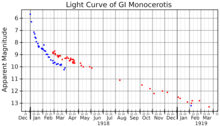 A Heidelberg Observatory photographic plate taken on 5 March 1918 showing the nova outburst of GI Monocerotis, compared with the same region photographed during the Sloan Digital Sky Survey more than 80 years later. | |
| Observation data Epoch J2000.0 Equinox J2000.0 | |
|---|---|
| Constellation | Monoceros |
| Right ascension | 07 26 47.107 |
| Declination | −06° 40′ 29.71″ |
| Apparent magnitude (V) | 5.6 - 18 |
| Characteristics | |
| Variable type | Nova |
| Astrometry | |
| Proper motion (μ) | RA: −2.955 mas/yr Dec.: 0.550 mas/yr |
| Parallax (π) | 0.2880 ± 0.0446 mas |
| Distance | approx. 11,000 ly (approx. 3,500 pc) |
| Absolute magnitude (MV) | −7.18 (max) +3.62 (min) |
| Details | |
| White dwarf | |
| Mass | 0.95±0.1 M☉ |
| Other designations | |
| GI Mon, Nova Monocerotis 1918, HD 58756, AAVSO 0721-06 | |
| Database references | |
| SIMBAD | data |

GI Monocerotis, also known as Nova Monocerotis 1918, was a nova that erupted in the constellation Monoceros during 1918. It was discovered by Max Wolf on a photographic plate taken at the Heidelberg Observatory on 4 February 1918. At the time of its discovery, it had a photographic magnitude of 8.5, and had already passed its peak brightness. A search of plates taken at the Harvard College Observatory showed that it had a photographic magnitude of 5.4 on 1 January 1918, so it would have been visible to the naked eye around that time. By March 1918 it had dropped to ninth or tenth magnitude. By November 1920 it was a little fainter than 15th magnitude.

A single pre-eruption photographic detection of GI Monocerotis exists, showing its magnitude was 15.1 before the nova event. GI Monoceros dropped by 3 magnitudes from its peak in about 23 days, making it a "fast nova". Long after the nova eruption, six small outbursts with a mean amplitude of 0.9 magnitudes were detected when the star was monitored from the year 1991 through 2000. Radio emission from the nova has been detected at the JVLA in the C (5 GHz), X (8 GHz) and K (23 GHz) bands.
All novae are binary stars, with a "donor" star orbiting a white dwarf. The two stars are so close together that matter is transferred from the donor star to the white dwarf. Worpel et al. report that the orbital period for the binary is probably 4.33 hours, and there is a 48.6 minute period which may represent the rotation period for the white dwarf. Their X-ray observations indicate that GI Mon is a non-magnetic cataclysmic variable star, meaning that the material lost from the donor star forms an accretion disk around the white dwarf, rather than flowing directly to the surface of the white dwarf. It is estimated that the donor star is transferring 3×10 M☉ of material to the accretion disk each year.
A 1995 search for an optically resolved nova remnant using the Anglo-Australian Telescope was unsuccessful.
References
- ^ Brown, A. G. A.; et al. (Gaia collaboration) (2021). "Gaia Early Data Release 3: Summary of the contents and survey properties". Astronomy & Astrophysics. 649: A1. arXiv:2012.01533. Bibcode:2021A&A...649A...1G. doi:10.1051/0004-6361/202039657. S2CID 227254300. (Erratum: doi:10.1051/0004-6361/202039657e). Gaia EDR3 record for this source at VizieR.
- Downes, Ronald; Webbink, Ronald F.; Shara, Michael M. (April 1997). "A Catalog and Atlas of Cataclysmic Variables-Second Edition". Publications of the Astronomical Society of the Pacific. 109: 345–440. Bibcode:1997PASP..109..345D. doi:10.1086/133900. S2CID 120396435.
- ^ Selvelli, Pierluigi; Gilmozzi, Roberto (February 2019). "A UV and optical study of 18 old novae with Gaia DR2 distances: mass accretion rates, physical parameters, and MMRD". Astronomy & Astrophysics. 622: A186. arXiv:1903.05868. Bibcode:2019A&A...622A.186S. doi:10.1051/0004-6361/201834238. S2CID 119234563.
- "GI Mon". SIMBAD. Centre de données astronomiques de Strasbourg. Retrieved 18 December 2020.
- ^ Duerbeck, Hilmar W. (March 1987). "A Reference Catalogue and Atlas of Galactic Novae". Space Science Reviews. 45 (1–2): 1–14. Bibcode:1987SSRv...45....1D. doi:10.1007/BF00187826. S2CID 115854775.
- Paddock, G.F. (June 1918). "Nova Monocerotis". Publications of the Astronomical Society of the Pacific. 30 (175): 189. Bibcode:1918PASP...30..189P. doi:10.1086/122722.
- Lampland, C.O. (January 1922). "Recent Photographic Observations of Several Well-Known Novae". Publications of the American Astronomical Society. 4: 221. Bibcode:1922PAAS....4..221L.
- Shapley, Harlow (January 1933). "The photographic light curves of 11 novae". Annals of the Astronomical Observatory of Harvard College. 84 (5): 121–155. Bibcode:1933AnHar..84..121S.
- ^ Robinson, E.L. (July 1975). "Preeruption light curves of novae". Astronomical Journal. 80: 515–524. Bibcode:1975AJ.....80..515R. doi:10.1086/111774.
- Honeycutt, R.K. (April 2001). "Similarities between Stunted Outbursts in Nova-like Cataclysmic Variables and Outbursts in Ordinary Dwarf Novae". The Publications of the Astronomical Society of the Pacific. 113 (782): 473–481. Bibcode:2001PASP..113..473H. doi:10.1086/319543. S2CID 123710633.
- Barrett, Paul E.; Dieck, Christopher; Beasley, Anthony J.; Singh, Kulinder P.; Mason, Paul A. (December 2017). "A Jansky VLA Survey of Magnetic Cataclysmic Variable Stars. I. The Data". Astronomical Journal. 154 (6): 252. arXiv:1702.07631. Bibcode:2017AJ....154..252B. doi:10.3847/1538-3881/aa93ff. S2CID 119055826.
- Worpel, H.; Schwope, A.D.; Traulsen, I.; Mukai, K.; Ok, S. (July 2020). "XMM-Newton observations of eleven intermediate polars and possible candidates". Astronomy & Astrophysics. 639: A17. arXiv:2005.12827. Bibcode:2020A&A...639A..17W. doi:10.1051/0004-6361/202038038. S2CID 219741478.
| Constellation of Monoceros | |||||||||||||
|---|---|---|---|---|---|---|---|---|---|---|---|---|---|
| Stars |
| ||||||||||||
| |||||||||||||
| Star clusters |
| ||||||||||||
| Nebulae |
| ||||||||||||
| Galaxies |
| ||||||||||||